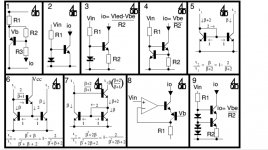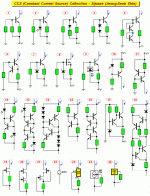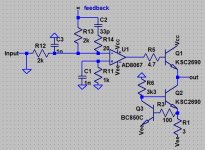Hi
17y ago I biased in class A my op amps and was very happy with the sonic result. I used a trim pot and found the best sonic result for these to be at 2.4mA. So back then I biased the AD825 with one resistor and one 2SK170. OK, back then AD825s were very expensive and 2SK170s not !
I want to do exactly that again, still with AD825, but obviously the situation has changed. I have many AD825 handy, but no one would want to waist SK170s on that.
Could someone please point me in the right direction to get a suitable transistor replacement, non expensive and easy to get from Mouser, if possible leg / pinout compatible, and of course the associated resistor value so I get 2.4mA (under 15V) ? Having the right resistor value would help me ordering all the parts in one go, part of a bulk purchase at Mouser’s…
In short exactly the same but transposed in today’s world « avoiding the use of SK170 🙂
Many thanks for your kind help
Claude
17y ago I biased in class A my op amps and was very happy with the sonic result. I used a trim pot and found the best sonic result for these to be at 2.4mA. So back then I biased the AD825 with one resistor and one 2SK170. OK, back then AD825s were very expensive and 2SK170s not !
I want to do exactly that again, still with AD825, but obviously the situation has changed. I have many AD825 handy, but no one would want to waist SK170s on that.
Could someone please point me in the right direction to get a suitable transistor replacement, non expensive and easy to get from Mouser, if possible leg / pinout compatible, and of course the associated resistor value so I get 2.4mA (under 15V) ? Having the right resistor value would help me ordering all the parts in one go, part of a bulk purchase at Mouser’s…
In short exactly the same but transposed in today’s world « avoiding the use of SK170 🙂
Many thanks for your kind help
Claude
Could someone please point me in the right direction to get a suitable transistor replacement, non expensive and easy to get from Mouser
MMBFJ175 to 177
2SK246
Ok, Thanks!
Let's pick either of them as an example, any idea regarding the resistor that I should order with it to get my 2.4mA?
Let's pick either of them as an example, any idea regarding the resistor that I should order with it to get my 2.4mA?
Ok, Thanks!
Let's pick either of them as an example, any idea regarding the resistor that I should order with it to get my 2.4mA?
In 300-1kOhm range based on specific transistor sample Idss and transconductance. They vary an order or so. Pick one, measure Idss, post there, i’ll answer more precise.
Thanks for the kind reply BesPav
However, that's exactly what I wanted to avoid: having to purchase, to measure, and to purchase again. Time and money consuming.
Is there really NO way to did it in one go, as I could do it in the past? That is purchasing a given transistor and a given resistor and getting sure one gets 2.4mA (say +-10%) under 15V?
In the past it was straight forward and no need to measure and order again: I just got the 2SK170 and a 100R resistor, job done. I found it once out and it truned out to work for all other 2SK170 with sufficient precision.
Can't it be done in a similar way with today's transistor?
Many thanks again
Claude
However, that's exactly what I wanted to avoid: having to purchase, to measure, and to purchase again. Time and money consuming.
Is there really NO way to did it in one go, as I could do it in the past? That is purchasing a given transistor and a given resistor and getting sure one gets 2.4mA (say +-10%) under 15V?
In the past it was straight forward and no need to measure and order again: I just got the 2SK170 and a 100R resistor, job done. I found it once out and it truned out to work for all other 2SK170 with sufficient precision.
Can't it be done in a similar way with today's transistor?
Many thanks again
Claude
I just got the 2SK170 and a 100R resistor, job done.
Heh... 2SK170 was a high transconductance one, so with small deviation you’ve got yours 2,4 +- 0,2 mA.
Can't it be done in a similar way with today's transistor?
Have no doubt, sure, it can.
Pick any you like more and i’ll calculate most nominals:


I’ll prefer 4 or 9 from first smaller collection.
Last edited:
Ok, still confused with all the options, but I believe we progress LOL
The scheme I am following is indeed on the page ctrlx just posted, unded
Method Two: The Lone JFET
In fact one JFET and one Resistor, exactly as on this section. That's it precisely, exactly how I connect it to my op amp.
That is simple, it works in my set up and I know how to do it as I did it already, LOL
Let's assume we stick to that one please.
Transistors can be
MMBFJ175, or 176, or 177... I don't mind either, if one is easier for calculation.
They are all available. Pity they don't come in the same shape as 2SK170 with its 3 long parallel legs, but hey ho, I can solder on the tiny pin legs and voilà.
Now, what Transistors and what R value?
Many thanks again
Claude
The scheme I am following is indeed on the page ctrlx just posted, unded
Method Two: The Lone JFET
In fact one JFET and one Resistor, exactly as on this section. That's it precisely, exactly how I connect it to my op amp.
That is simple, it works in my set up and I know how to do it as I did it already, LOL
Let's assume we stick to that one please.
Transistors can be
MMBFJ175, or 176, or 177... I don't mind either, if one is easier for calculation.
They are all available. Pity they don't come in the same shape as 2SK170 with its 3 long parallel legs, but hey ho, I can solder on the tiny pin legs and voilà.
Now, what Transistors and what R value?
Many thanks again
Claude
Transistors can be
MMBFJ175, or 176, or 177... I don't mind either, if one is easier for calculation.
Now, what Transistors and what R value?
Pick 175. It will require less voltage drop for reliable opamp output swing.
It needs source ~1,5 V lower than gate, so 680 Ohms will provide you with more or less precise 2-3 mA.
Also pick 470 and 860 Ohms for more precise current tuning.
Hi Claude
Unfortunately the jfet IDSS value range is wide so you will have to experiment to get your 2.4ma. I suggest to use a trim pot to find the possibly different value for each channel. You can replace afterwards with a fix resistor value.
I use the low cost J112 jfet in same package as 2sk170. The j112 has an IDSS range from 2 to 5ma but you would be unlucky to get IDSS lower than 2.4ma. Even then I suppose that the difference in sound between worst case 2ma and the desired 2.4ma may be marginal...
The j111 has a wider IDSS but maybe more tricky since at 25ma you could blow your opamp...
Pay attention that j112 and 2sk170 have a different pin out (gate and source).
Fab
Unfortunately the jfet IDSS value range is wide so you will have to experiment to get your 2.4ma. I suggest to use a trim pot to find the possibly different value for each channel. You can replace afterwards with a fix resistor value.
I use the low cost J112 jfet in same package as 2sk170. The j112 has an IDSS range from 2 to 5ma but you would be unlucky to get IDSS lower than 2.4ma. Even then I suppose that the difference in sound between worst case 2ma and the desired 2.4ma may be marginal...
The j111 has a wider IDSS but maybe more tricky since at 25ma you could blow your opamp...
Pay attention that j112 and 2sk170 have a different pin out (gate and source).
Fab
Last edited:
Hi BesPav
Thanks for the spot on response, that's what I needed.
So I can pick 175 and indeed picking a few additional R for fine tuning, that's the solution range I was hoping for
Have a nice Sun eve
Claude
Thanks for the spot on response, that's what I needed.
So I can pick 175 and indeed picking a few additional R for fine tuning, that's the solution range I was hoping for
Have a nice Sun eve
Claude
Hi Fab
I guess it is a bit your "fault" if I am getting started again with Audio project. Don't ask me how I went from a simple amp replacement in my existing amp to now what looks like separate additional boxes (got your point, you were right re flexibility) and starting with a pre pre to get to a preamp... argh! 🙂
Yes, from 2mA to 3mA the sonic difference isn't big and yes 17y ago I used trimmers to get the value I needed (before going solid resistors)... And I still have them.
Thanks for the J112 fet tip, these are excellent alternatives aswell as possibly easier to solder in my case. As BesPav did, do you perhaps have some resistor values to give me so I could fine tune the sound (so I could order the resistors values at the same time)?
Merci beaucoup une nouvelle fois et bon dimanche
Claude
I guess it is a bit your "fault" if I am getting started again with Audio project. Don't ask me how I went from a simple amp replacement in my existing amp to now what looks like separate additional boxes (got your point, you were right re flexibility) and starting with a pre pre to get to a preamp... argh! 🙂
Yes, from 2mA to 3mA the sonic difference isn't big and yes 17y ago I used trimmers to get the value I needed (before going solid resistors)... And I still have them.
Thanks for the J112 fet tip, these are excellent alternatives aswell as possibly easier to solder in my case. As BesPav did, do you perhaps have some resistor values to give me so I could fine tune the sound (so I could order the resistors values at the same time)?
Merci beaucoup une nouvelle fois et bon dimanche
Claude
Hi Claude
There is no way to predict which value since IDSS of jfet varies too much [2-5]ma.
If RS=0 then you have full IDSS current. Therefore 2.4ma as ID may be anything between 0 ohms and 1K ohms. You could order standard values such as 47, 100, 150, 220, 360, 470, 680, 820, 1K ohms.
Fab
There is no way to predict which value since IDSS of jfet varies too much [2-5]ma.
If RS=0 then you have full IDSS current. Therefore 2.4ma as ID may be anything between 0 ohms and 1K ohms. You could order standard values such as 47, 100, 150, 220, 360, 470, 680, 820, 1K ohms.
Fab
Last edited:
...right direction to get a suitable transistor replacement, non expensive and easy to get from Mouser, ... so I get 2.4mA ...
1N5307
Mouser #: 610-1N5307_PB
Maximum Regulator Current: 2.42 mA
In Stock: 2,929, $5.93
https://www.mouser.com/datasheet/2/68/1n5283-5314-1159786.pdf
The 6-buck price is outrageous; however you don't need a resistor and you DO get the current you asked for.
Here' s a working circuit, measured circuit you can try
A Universal Small Signal Class A Buffer V1.0.pdf
DIY audi member jcx also showed a trick a few yeas ago. If you buffer the opamp with the class A circuit as shown in the link above, you can connect a resistor from the op-amps output to the emiter of the follower to bias the opamp OPS into class A. If you use a 270 Ohms resistor this will bias the opamp OPS at about 2.5mA class A.
A Universal Small Signal Class A Buffer V1.0.pdf
DIY audi member jcx also showed a trick a few yeas ago. If you buffer the opamp with the class A circuit as shown in the link above, you can connect a resistor from the op-amps output to the emiter of the follower to bias the opamp OPS into class A. If you use a 270 Ohms resistor this will bias the opamp OPS at about 2.5mA class A.
Last edited:
If you buffer the opamp with the class A circuit as shown in the link above, you can connect a resistor from the op-amps output to the emiter of the follower to bias the opamp OPS into class A. If you use a 270 Ohms resistor this will bias the opamp OPS at about 2.5mA class A.
Unneeded.
Follower’s BJT base current will unconditionally bias opamp’s output.
- Home
- Source & Line
- Analog Line Level
- class A bias help
